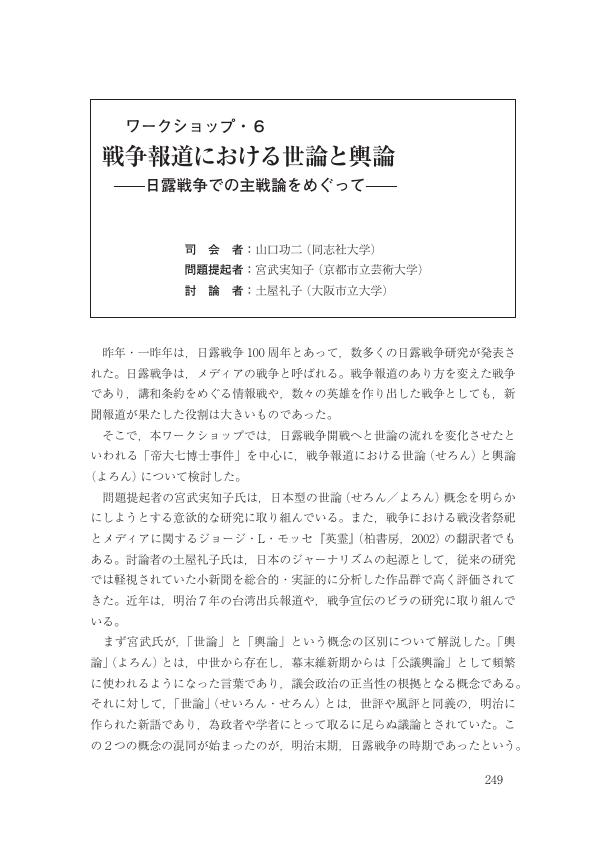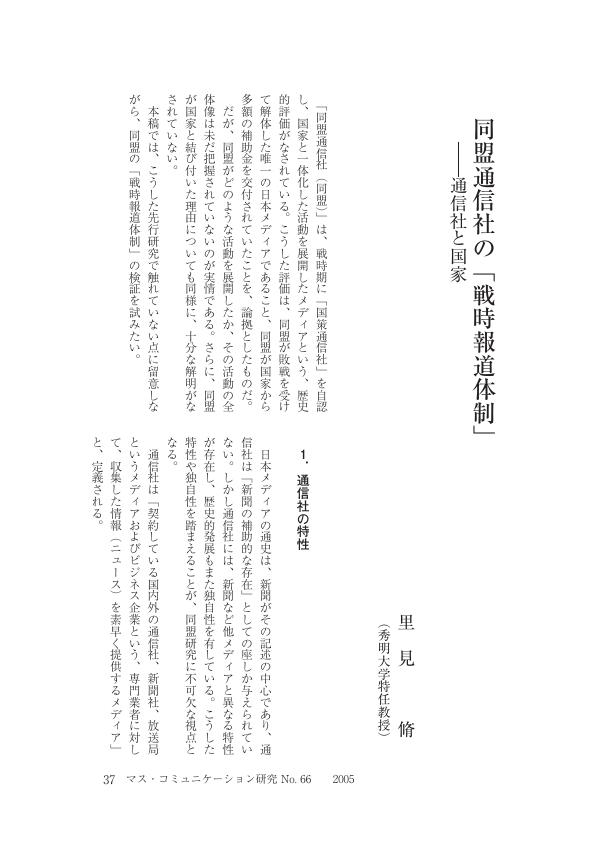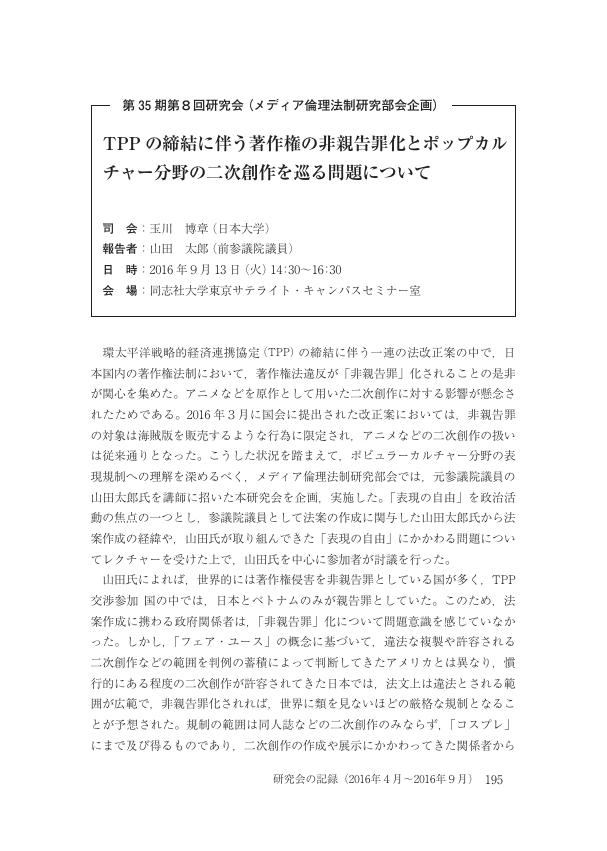- 著者
- 嵯峨 景子
- 出版者
- 日本マス・コミュニケーション学会
- 雑誌
- マス・コミュニケーション研究 (ISSN:13411306)
- 巻号頁・発行日
- vol.78, pp.129-147, 2011-01-31 (Released:2017-10-06)
- 参考文献数
- 10
This paper aims at examining the process of creation and change of readers' community in the magazine "Jyogaku Sekai". For this purpose, I analyzed the letters from readers, and discussed about the historical transition of their writing and communication style. Through a past quantitative analysis, it became clear that a large change has occurred around 1916. At first, a major function of the readers' column was exchanging information about daily life, postcards, books, and etc. However, around 1916, the function of exchanging information disappeared, and the letters of readers became more fictional, romantic, and daydreaming. A use of pen name, graceful style of writing, and sentimental motif spread among girls, these elements established the friendships of readers, and the romantic community was made by the function trough the magazine. I summarize that the large change has occurred based on the decline in the age of readers, the expansion of female magazine market, and development of girl culture in Taisho era.
2 0 0 0 OA ローカル新聞と日露戦争 : 豊橋『新朝報』における読者参加を例に
- 著者
- 小川 明子
- 出版者
- 日本メディア学会
- 雑誌
- マス・コミュニケーション研究 (ISSN:13411306)
- 巻号頁・発行日
- vol.75, pp.92-110, 2009-07-31 (Released:2017-10-06)
- 参考文献数
- 23
During the Russo-Japan War, newspaper companies located in the urban areas such as Osaka and Tokyo tried to broaden their distribution by investing large capital to install telecommunication facilities and visual technologies. Taking advantage of these new technologies, large newspaper attempted to attract people's attention by distributing the news promptly. This article examines how the local newspaper competed with these newspapers during the war. It shed light on "Shinchoho," a small local newspaper, in Toyohashi at that time. Investigating the strategies by the paper to survive, this paper discusses how the local newspaper interacted with the local readers.
- 著者
- 山口 功二 宮武 実知子 土屋 礼子
- 出版者
- 日本メディア学会
- 雑誌
- マス・コミュニケーション研究 (ISSN:13411306)
- 巻号頁・発行日
- vol.70, pp.249-250, 2007-01-30 (Released:2017-10-06)
2 0 0 0 OA 米国における防諜法と取材報道の自由
- 著者
- 大塚 一美
- 出版者
- 日本マス・コミュニケーション学会
- 雑誌
- マス・コミュニケーション研究 (ISSN:13411306)
- 巻号頁・発行日
- vol.86, pp.83-102, 2015-01-31 (Released:2017-10-06)
- 参考文献数
- 26
- 被引用文献数
- 1
This study aims to examine the influence of the Espionage Act of 1917 on freedom of the press in the United States. This article consists of the following sections. The first section introduces the outline of the system for classifying state secrets and the Espionage Act. The second section presents problems in the Espionage Act regarding freedom of the press. The third section provides cases that show the tendency to broadly apply the Espionage Act. The last section considers the strict control of access to information under the Espionage Act by the Obama administration. This study concludes that the Espionage Act has had a damaging effect on freedom of the press for the following reasons. Prosecuting people who divulge information brings about the chilling effect of furnishing the information. Government officials are increasingly afraid to talk to journalists. This situation is especially serious in the Obama administration compared with all previous U.S. administrations because of the aggressive prosecution of people who have divulged classified information. Although the Justice Department has never prosecuted journalists for violating the Espionage Act, there are dangerous attempts to prosecute individuals who act like journalists. In addition, the U.S. Supreme Court ruled against a journalist forced to reveal his source who disclosed information illegally. Laws and systems for protecting state secrets in which provisions are ambiguous and interpretations thereof are arbitrary infringe on civil liberties. Moreover, broad electronic information surveillance also deters sources from providing information to journalists. These problems occur not only in the United States but in Japan also. Because the Special Secrecy Law in Japan has no regard for the people's right to know, conditions in Japan will worsen with the enforcement of this law.
2 0 0 0 OA 言語行為としての広告 : その逆説的性格
- 著者
- 辻 大介
- 出版者
- 日本メディア学会
- 雑誌
- マス・コミュニケーション研究 (ISSN:13411306)
- 巻号頁・発行日
- vol.52, pp.104-117, 1998-01-31 (Released:2017-10-06)
- 被引用文献数
- 1
2 0 0 0 OA オーディエンス/像をめぐる「受動性」概念の再検討 : 「衝撃の受動性」を手がかりに
- 著者
- 鍵本 優
- 出版者
- 日本マス・コミュニケーション学会
- 雑誌
- マス・コミュニケーション研究 (ISSN:13411306)
- 巻号頁・発行日
- vol.69, pp.57-72, 2006-07-31 (Released:2017-10-06)
- 参考文献数
- 32
The audience has been caught from the passive / active audience to the diffused state of audience image by the socio-cultural positions. However, the present approach is only to discuss the semantic interpretations of the contents of media. In this paper, the audience experience about "passivity of shock" is mentioned. It is connected with the view of "body as a field." And by reconsidering the perspective that grasps audience / image, it is argued critically that the conventional "passivity" cannot deal with the problem of "passivity of shock." Furthermore, this paper proposes the direction in which "passivity" concept is reconsidered.
2 0 0 0 OA オーディエンスの身体 音楽享受をめぐって
- 著者
- 鍵本 優
- 出版者
- 日本マス・コミュニケーション学会
- 雑誌
- マス・コミュニケーション研究 (ISSN:13411306)
- 巻号頁・発行日
- vol.66, pp.74-90, 2005-01-31 (Released:2017-10-06)
- 参考文献数
- 33
The paper attempts to relate two modes of enjoying music for audience. One is identifying with others or ideas through interpreting about the meaning. The other is the identification toward nothingness through the textural reception of sounds. The way of discussion is to reconsider the body of audience as a field theoretically. This paper suggests that there are four directions of enjoying music with the change of the image of a body. In conclusion, the experience of music audience is that the multilayer images of a body are changing and being connected with each other in the process of reception.
- 著者
- 山腰 修三
- 出版者
- 日本メディア学会
- 雑誌
- マス・コミュニケーション研究 (ISSN:13411306)
- 巻号頁・発行日
- vol.85, pp.5-23, 2014-07-31 (Released:2017-10-06)
- 参考文献数
- 33
- 被引用文献数
- 1
The objective of this paper is to consider, from an analytical perspective, forms of political participation in the contemporary media landscape. Political communication theory faces a difficult question: how to analyze the diverse forms of political participation that use digital media. Political participation in the digital age is explained in terms of "networks." For example, Manuel Castells advocates that the development of digitalization stimulates political participation and leads to political and social changes. Though this approach is broadly accepted, the "network society" theory has been criticized because of its failure to analyze the power struggle dimension in political communication. As some critics point out, Castells has not described adequately how the new media landscape forms society, and what resistance and struggles are generated within it. This paper refers to Nick Couldry's media theory as an alternative approach. Through his original theory of media power, he describes the formation of contemporary society as constructed by media practice and media representation. According to his theoretical framework, he argues for the possibility of political participation in the formation of a neoliberal political-social order. This paper focuses into Couldry's two concepts, "voice" and "hearing," and argues that these are new analytical tools for political participation and political communication.
2 0 0 0 OA BPO と放送の自由 放送人権委員会の決定に見る課題
- 著者
- 佐藤 潤司
- 出版者
- 日本メディア学会
- 雑誌
- マス・コミュニケーション研究 (ISSN:13411306)
- 巻号頁・発行日
- vol.93, pp.77-96, 2018-07-31 (Released:2018-10-13)
- 参考文献数
- 14
This paper discusses the danger that the BPO, which should be obliged toact as a bulwark against public authorities intervening in program production,may threaten the freedom of broadcasting and intimidate broadcasters. The aim of this paper is to investigate several cases in which TV stationssubmitted their reports in order to officially express objections to BPO’s decisionsand to clarify the problems of these decisions and issues that the BPOshould resolve. Through the examination of four cases that fit the above conditions, someproblematic decisions were revealed which the BRC, one of the BPO committees,had made. These include one case in which the BRC pointed out ethicalproblems in TV programs based on a misunderstanding of the facts and mistakeninterpretations by the BRC, and another case in which they concludedthat human rights were violated based on information that had not been broadcasted. The BRC should have an obligation to examine factual information, conductverification, clarify the standards of judgment, share their understanding ofbroadcasting ethics with TV stations, in order to make equal and fair judgmentsto regain the trust of broadcasters.The BPO should take these BRC-related problems seriously and become atrue guardian of the freedom of broadcasting, defending the media from theauthorities that intend to intervene in the broadcasting industry.
2 0 0 0 OA 同盟通信社の「戦時報道体制」 通信社と国家
- 著者
- 里見 脩
- 出版者
- 日本マス・コミュニケーション学会
- 雑誌
- マス・コミュニケーション研究 (ISSN:13411306)
- 巻号頁・発行日
- vol.66, pp.37-54, 2005-01-31 (Released:2017-10-06)
- 参考文献数
- 18
- 著者
- 松井 広志
- 出版者
- 日本マス・コミュニケーション学会
- 雑誌
- マス・コミュニケーション研究 (ISSN:13411306)
- 巻号頁・発行日
- vol.98, pp.19-32, 2021
<p>This paper examines video games in order to discuss roles played by media culture during the COVID-19 pandemic. In 2020, people spent a large amount of their time playing communication-oriented games, such as "Animal Crossing: New Horizons," or social multiplayer games on smartphones. This trend is an extension of the casual revolution in video games since the 2000s.</p><p>Notably, however, communication-oriented games during the pandemic also seem to offer alternative means for casual ordinary communication in the abnormal reality imposed by the pandemic. Their popularity is a sign of new roles played by media culture and games.</p>
2 0 0 0 OA 『週刊少年ジャンプ』という時代経験: 解釈枠組みとしてのマスター・ナラティブ
- 著者
- 池上 賢
- 出版者
- 日本マス・コミュニケーション学会
- 雑誌
- マス・コミュニケーション研究 (ISSN:13411306)
- 巻号頁・発行日
- vol.75, pp.149-167, 2009-07-31 (Released:2017-10-06)
- 参考文献数
- 19
The purpose of this study is to analyze how audiences tells and give meanings to experiences of manga including "Weekly Shonen Jump", which was the most famous manga magazine in Japan in the 1980s through the early 1990s. I focused on the master narrative which would become the frame of experience. For the method I was analyzed life-story interview data of five informants and their manga experiences. As a result, it was revealed that the reflexivity in which social discourses about media play an important roll in relationship between audience and media.
2 0 0 0 OA ^[○!R]台湾における日本恋愛ドラマと日本イメージの関係について
- 著者
- 李 衣雲
- 出版者
- 日本マス・コミュニケーション学会
- 雑誌
- マス・コミュニケーション研究 (ISSN:13411306)
- 巻号頁・発行日
- no.69, pp.108-125, 2006-07-31
This thesis deals with the image produced by Japanese dramas which were broadcasted in Taiwan mainly from 1992 to 2000. Comparing with the other dramas broadcasted in Taiwan during that period, Japanese dramas had a bourgeoisie feel in taste and fashion. The filming techniques also created the air of romance. The consumer desires were prompted by such air and a romanticized Japanese image was contrived by the Taiwanese audience through these Japanese dramas. Thus, when the audience visited Japan, they felt a gap between the image and the reality.
2 0 0 0 OA インターネット掲示板においてテレビ番組はどのように語られるのか^[○!R]
- 著者
- 山本 明
- 出版者
- 日本マス・コミュニケーション学会
- 雑誌
- マス・コミュニケーション研究 (ISSN:13411306)
- 巻号頁・発行日
- no.78, pp.149-167, 2011-01-31
This study analyzes the messages written about the Japanese television program "24-Hour Television: Love Saves the Earth" on the website "2 channel," the most popular online community in Japan. The study explores the comments on this television program in the online community by evaluating the features of TV watching when the program is viewed with writing messages online, and examines the various motives of the contributors of writing online. Previous studies indicated that internet users tend to be involved in "24-Hour Television"; hence, this study also explores why this show attracts so many internet users. Text mining of the messages written in "2 channel" revealed that people wrote comments as same time as they were watching TV. In their comments, the words used to express their impressions of the TV show were "kando (impression)" and "gizen (hypocrisy)." These comments suggest that the major features of their TV watching style are "tsukkomi" (to play the straight man) and "urayomi" (to guess behind the production of this show). The results also suggest that the main motive for writing their comments in the online community is social interaction (to share their emotions with the show and their watching experiences). Hence from comments on this show, it is suggested that this show's live in "2 channel" has already annual event to "2 channel" users and this show's characteristics maybe fit for live in "2 channel". It also seems that the motives for writing messages in community sites while watching TV and the features of TV programs that stimulate online messages may be common to all messages about TV in online community sites.
- 著者
- 松井 広志
- 出版者
- 日本マス・コミュニケーション学会
- 雑誌
- マス・コミュニケーション研究 (ISSN:13411306)
- 巻号頁・発行日
- vol.93, pp.145-146, 2018
- 著者
- 片野 利彦
- 出版者
- 日本マス・コミュニケーション学会
- 雑誌
- マス・コミュニケーション研究 (ISSN:13411306)
- 巻号頁・発行日
- vol.97, pp.211-212, 2020
- 著者
- 山口 功二
- 出版者
- 日本マス・コミュニケーション学会
- 雑誌
- マス・コミュニケーション研究 (ISSN:13411306)
- 巻号頁・発行日
- vol.81, pp.185-186, 2012-07-31 (Released:2017-10-06)
- 著者
- 宮﨑 悠二
- 出版者
- 日本マス・コミュニケーション学会 ; 1993-
- 雑誌
- マス・コミュニケーション研究 = Journal of mass communication studies (ISSN:13411306)
- 巻号頁・発行日
- no.98, pp.107-124, 2021
- 著者
- 上原 伸元
- 出版者
- 日本マス・コミュニケーション学会
- 雑誌
- マス・コミュニケーション研究 (ISSN:13411306)
- 巻号頁・発行日
- vol.90, pp.195-196, 2017-01-31 (Released:2017-10-06)
2 0 0 0 OA 1870 年代の小新聞における「下等社会」と階層認識
- 著者
- 石堂 彰彦
- 出版者
- 日本マス・コミュニケーション学会
- 雑誌
- マス・コミュニケーション研究 (ISSN:13411306)
- 巻号頁・発行日
- vol.76, pp.255-273, 2010-01-31 (Released:2017-10-06)
- 参考文献数
- 25
This paper aims to clarify class-consciousness and its changing processappeared in popular newspapers in early modern Japan. The research is basedon a study of the /Yomiuri Shimbun/, /Tokyo Eiri Shimbun/, /Kanayomi Shimbun/and some other newspapers in 1870s. Until 1877, in the trend of civilization, writers and contributors of popularnewspapers had admonished urban people who were mainly comprised of artisansand rickshaw drivers. But from mid-1877, as the trend became weaker, themedia began to consider it unnecessary to admonish them anymore, and startedto call them“ inferior class”






